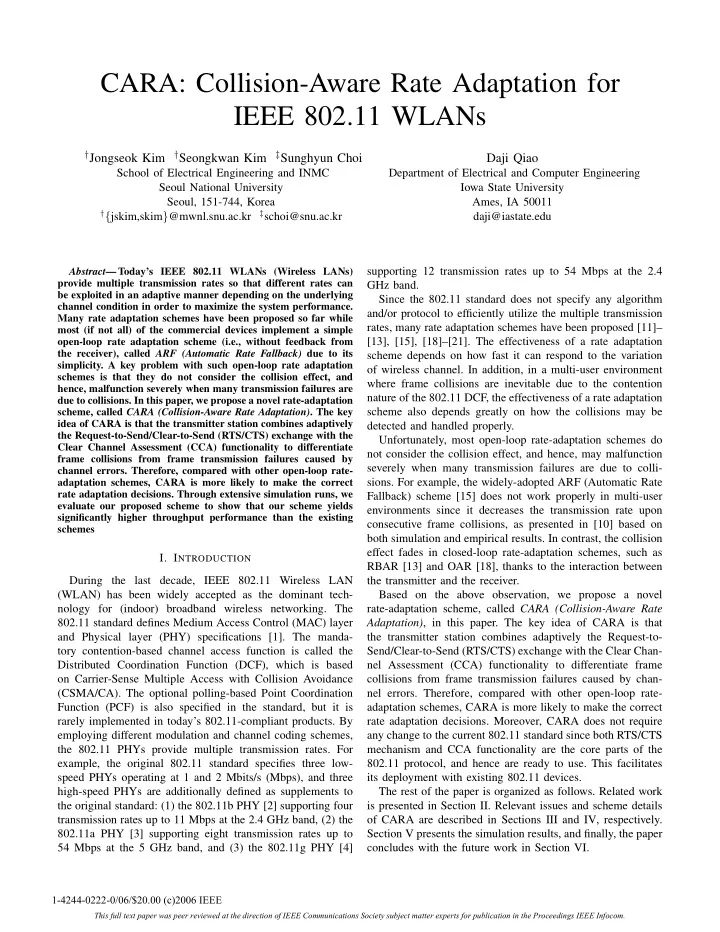

CARA: Collision-Aware Rate Adaptation for IEEE 802.11 WLANs † Jongseok Kim † Seongkwan Kim ‡ Sunghyun Choi Daji Qiao School of Electrical Engineering and INMC Department of Electrical and Computer Engineering Seoul National University Iowa State University Seoul, 151-744, Korea Ames, IA 50011 † { jskim,skim } @mwnl.snu.ac.kr ‡ schoi@snu.ac.kr daji@iastate.edu supporting 12 transmission rates up to 54 Mbps at the 2.4 Abstract — Today’s IEEE 802.11 WLANs (Wireless LANs) provide multiple transmission rates so that different rates can GHz band. be exploited in an adaptive manner depending on the underlying Since the 802.11 standard does not specify any algorithm channel condition in order to maximize the system performance. and/or protocol to efficiently utilize the multiple transmission Many rate adaptation schemes have been proposed so far while rates, many rate adaptation schemes have been proposed [11]– most (if not all) of the commercial devices implement a simple [13], [15], [18]–[21]. The effectiveness of a rate adaptation open-loop rate adaptation scheme (i.e., without feedback from the receiver), called ARF (Automatic Rate Fallback) due to its scheme depends on how fast it can respond to the variation simplicity. A key problem with such open-loop rate adaptation of wireless channel. In addition, in a multi-user environment schemes is that they do not consider the collision effect, and where frame collisions are inevitable due to the contention hence, malfunction severely when many transmission failures are nature of the 802.11 DCF, the effectiveness of a rate adaptation due to collisions. In this paper, we propose a novel rate-adaptation scheme, called CARA (Collision-Aware Rate Adaptation) . The key scheme also depends greatly on how the collisions may be idea of CARA is that the transmitter station combines adaptively detected and handled properly. the Request-to-Send/Clear-to-Send (RTS/CTS) exchange with the Unfortunately, most open-loop rate-adaptation schemes do Clear Channel Assessment (CCA) functionality to differentiate not consider the collision effect, and hence, may malfunction frame collisions from frame transmission failures caused by severely when many transmission failures are due to colli- channel errors. Therefore, compared with other open-loop rate- sions. For example, the widely-adopted ARF (Automatic Rate adaptation schemes, CARA is more likely to make the correct rate adaptation decisions. Through extensive simulation runs, we Fallback) scheme [15] does not work properly in multi-user evaluate our proposed scheme to show that our scheme yields environments since it decreases the transmission rate upon significantly higher throughput performance than the existing consecutive frame collisions, as presented in [10] based on schemes both simulation and empirical results. In contrast, the collision effect fades in closed-loop rate-adaptation schemes, such as I. I NTRODUCTION RBAR [13] and OAR [18], thanks to the interaction between During the last decade, IEEE 802.11 Wireless LAN the transmitter and the receiver. (WLAN) has been widely accepted as the dominant tech- Based on the above observation, we propose a novel nology for (indoor) broadband wireless networking. The rate-adaptation scheme, called CARA (Collision-Aware Rate 802.11 standard defines Medium Access Control (MAC) layer Adaptation) , in this paper. The key idea of CARA is that and Physical layer (PHY) specifications [1]. The manda- the transmitter station combines adaptively the Request-to- tory contention-based channel access function is called the Send/Clear-to-Send (RTS/CTS) exchange with the Clear Chan- Distributed Coordination Function (DCF), which is based nel Assessment (CCA) functionality to differentiate frame on Carrier-Sense Multiple Access with Collision Avoidance collisions from frame transmission failures caused by chan- (CSMA/CA). The optional polling-based Point Coordination nel errors. Therefore, compared with other open-loop rate- Function (PCF) is also specified in the standard, but it is adaptation schemes, CARA is more likely to make the correct rarely implemented in today’s 802.11-compliant products. By rate adaptation decisions. Moreover, CARA does not require employing different modulation and channel coding schemes, any change to the current 802.11 standard since both RTS/CTS the 802.11 PHYs provide multiple transmission rates. For mechanism and CCA functionality are the core parts of the example, the original 802.11 standard specifies three low- 802.11 protocol, and hence are ready to use. This facilitates speed PHYs operating at 1 and 2 Mbits/s (Mbps), and three its deployment with existing 802.11 devices. high-speed PHYs are additionally defined as supplements to The rest of the paper is organized as follows. Related work the original standard: (1) the 802.11b PHY [2] supporting four is presented in Section II. Relevant issues and scheme details transmission rates up to 11 Mbps at the 2.4 GHz band, (2) the of CARA are described in Sections III and IV, respectively. 802.11a PHY [3] supporting eight transmission rates up to Section V presents the simulation results, and finally, the paper 54 Mbps at the 5 GHz band, and (3) the 802.11g PHY [4] concludes with the future work in Section VI. 1-4244-0222-0/06/$20.00 (c)2006 IEEE This full text paper was peer reviewed at the direction of IEEE Communications Society subject matter experts for publication in the Proceedings IEEE Infocom.
Recommend
More recommend